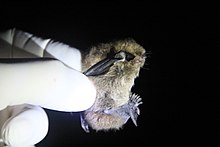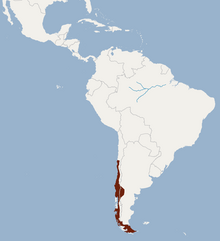Chilean myotis
| Chilean myotis | |
|---|---|
 | |
Conservation status | |
| Scientific classification | |
| Domain: | Eukaryota |
| Kingdom: | Animalia |
| Phylum: | Chordata |
| Class: | Mammalia |
| Order: | Chiroptera |
| Family: | Vespertilionidae |
| Genus: | Myotis |
| Species: | M. chiloensis |
| Binomial name | |
| Myotis chiloensis (Waterhouse, 1840) | |
 | |
The Chilean myotis (Myotis chiloensis) is a species of vesper bat found in southern South America.
Description
The Chilean myotis is a small bat, measuring only 7 to 9 cm (2.8 to 3.5 in) in total length, including the tail, and weighing about 7 g (0.25 oz). The colour of their fur varies with latitude, from pale ochraceous in the north to coffee-brown in the south. They have a wing aspect ratio of 5.8, suggesting that they are slow, but highly manoeuvrable, in flight. The tail is entirely enclosed within the uropatagium.[2]
Distribution and habitat
Apart from the southern big-eared brown bat, which lives in the same general locality, the Chilean myotis lives further south than any other bat species in the world.[2] The species lives primarily in Chile, south of about 30°S, but is also found in the westernmost regions of the Argentinian provinces of Neuquén, Río Negro, and Chubut. At the extreme southern end of its range, it is found across Tierra del Fuego, in both the Chilean and Argentinian parts of the island.[3] Over this wide area, it ranges from the semi-arid Chilean Matorral in the north to temperate and evergreen forests in the south.[2][4]
There are no currently recognised subspecies, although the montane and Atacama myotises, which live further north in western South America, and are now considered species in their own right, were formerly considered to be subspecies of M. chiloensis.[2]
Biology and behaviour
Chilean myotises roost in holes in trees, rock crevices, caves, and artificial structures such as attic spaces. They emerge at dusk, and feed for about three hours before returning home to roost; unlike most other bats they do not feed again later in the night. Because of their small size and low metabolic rate, the bats often enter a daily period of torpor during which their body temperature falls to just 0.5 °C above ambient.[2]
They feed on flies that they capture on the wing, particularly including nematocerans such as crane flies.[5] Their echolocation calls consist of a downward frequency modulated segment followed by a narrowband component at a relatively constant frequency. Search calls sweep down from 89 to 39 kHz, and are emitted at intervals of about 95 milliseconds.[6] Females give birth to a single young at the beginning of summer.[2]
References
- ^ Barquez, R.; Diaz, M. (2016). "Myotis chiloensis". IUCN Red List of Threatened Species. 2016: e.T14151A22061103. doi:10.2305/IUCN.UK.2016-3.RLTS.T14151A22061103.en. Retrieved 16 November 2021.
- ^ a b c d e f Ossa, G. & Rodríguez-San Pedro, A. (August 2015). "Myotis chiloensis (Chiroptera: Vespertilionidae)". Mammalian Species. 47 (922): 51–56. doi:10.1093/mspecies/sev005.
- ^ Barquez, R. & Diaz, M. (2008). "Myotis chiloensis". IUCN Red List of Threatened Species. 2008: e.T14151A4410480.
- ^ Maynard, C.N.; et al. (July 2014). "Bats of the Chilean temperate rainforest: patterns of landscape use in a mosaic of native forests, eucalyptus plantations and grasslands within a South American biodiversity hotspot". Biodiversity and Conservation. 23 (8): 1949–1963. doi:10.1007/s10531-014-0697-3. S2CID 13988668.
- ^ Koopman, K.F. (August 1967). "The Southernmost Bats". Journal of Mammalogy. 48 (3): 487–488. doi:10.2307/1377795. JSTOR 1377795.
- ^ Rodríguez-San Pedro, A. & Simonetti, J.A. (January 2013). "Acoustic identification of four species of bats (Order Chiroptera) in central Chile". Bioacoustics. 22 (2): 165–172. doi:10.1080/09524622.2013.763384. hdl:10533/133211. S2CID 85002402.
- v
- t
- e
- Kingdom: Animalia
- Phylum: Chordata
- Class: Mammalia
- Order: Chiroptera
- Family: Vespertilionidae
- Subfamily: Myotinae
- Large-footed bat (M. adversus)
- Southern myotis (M. aelleni)
- Silver-tipped myotis (M. albescens)
- Myotis alcathoe (M. alcathoe)
- Szechwan myotis (M. altarium)
- Anjouan myotis (M. anjouanensis)
- Annamit myotis (M. annamiticus)
- M. annatessae
- Hairy-faced bat (M. annectans)
- Atacama myotis (M. atacamensis)
- Peters's myotis (M. ater)
- Sir David Attenborough's myotis (M. attenboroughi)
- Southwestern myotis (M. auriculus)
- Australian myotis (M. australis)
- Southeastern myotis (M. austroriparius)
- Chestnut myotis (M. badius)
- M. bartelsi
- Bechstein's bat (M. bechsteinii)
- Lesser mouse-eared bat (M. blythii)
- Rufous mouse-eared bat (M. bocagii)
- Far Eastern myotis (M. bombinus)
- Brandt's bat (M. brandtii)
- Bocharic myotis (M. bucharensis)
- California myotis (M. californicus)
- Long-fingered bat (M. capaccinii)
- Chilean myotis (M. chiloensis)
- Large myotis (M. chinensis)
- Western small-footed bat (M. ciliolabrum)
- Guatemalan myotis (M. cobanensis)
- Cryptic myotis (Myotis crypticus)
- Csorba's mouse-eared bat (M. csorbai)
- Pond bat (M. dasycneme)
- Daubenton's bat (M. daubentonii)
- David's myotis (M. davidii)
- Kock's mouse-eared bat (M. dieteri)
- M. diminutus
- Dominican myotis (M. dominicensis)
- Elegant myotis (M. elegans)
- Geoffroy's bat (M. emarginatus)
- M. escalerai
- Long-eared myotis (M. evotis)
- M. fimbriatus
- Findley's myotis (M. findleyi)
- M. flavus
- Hodgson's bat (M. formosus)
- Cinnamon myotis (M. fortidens)
- Fraternal myotis (M. frater)
- Gomantong myotis (M. gomantongensis)
- Malagasy mouse-eared bat (M. goudoti)
- Gray bat (M. grisescens)
- Armenian whiskered bat (M. hajastanicus)
- M. handleyi
- Lesser large-footed bat (M. hasseltii)
- Herman's myotis (M. hermani)
- Horsfield's bat (M. horsfieldii)
- M. hyrcanicus
- Ikonnikov's bat (M. ikonnikovi)
- M. indochinensis
- Insular myotis (M. insularum)
- M. izecksohni
- Hairy-legged myotis (M. keaysi)
- Keen's myotis (M. keenii)
- Chinese water myotis (M. laniger)
- M. lavali
- Eastern small-footed myotis (M. leibii)
- Yellowish myotis (M. levis)
- Kashmir cave bat (M. longipes)
- Little brown bat (M. lucifugus)
- Eastern long-fingered bat (M. macrodactylus)
- M. macropus
- Pallid large-footed myotis (M. macrotarsus)
- Schwartz's myotis (M. martiniquensis)
- Dark-nosed small-footed myotis (M. melanorhinus)
- M. midastactus
- Maluku myotis (M. moluccarum)
- Burmese whiskered bat (M. montivagus)
- Morris's bat (M. morrisi)
- Wall-roosting mouse-eared bat (M. muricola)
- Greater mouse-eared bat (M. myotis)
- Whiskered bat (M. mystacinus)
- Natterer's bat (M. nattereri)
- Curacao myotis (M. nesopolus)
- Black myotis (M. nigricans)
- Nimba mountain bat (M. nimbaensis)
- Nepal myotis (M. nipalensis)
- M. nyctor
- Arizona myotis (M. occultus)
- Singapore whiskered bat (M. oreias)
- Montane myotis (M. oxyotus)
- Peninsular myotis (M. peninsularis)
- Beijing mouse-eared bat (M. pequinius)
- Eastern water bat (M. petax)
- M. phanluongi
- Flat-headed myotis (M. planiceps)
- Frosted myotis (M. pruinosus)
- Felten's myotis (M. punicus)
- Rickett's big-footed bat (M. ricketti)
- Ridley's bat (M. ridleyi)
- Riparian myotis (M. riparius)
- Thick-thumbed myotis (M. rosseti)
- Red myotis (M. ruber)
- Schaub's myotis (M. schaubi)
- Scott's mouse-eared bat (M. scotti)
- Northern long-eared bat (M. septentrionalis)
- M. sibiricus
- Mandelli's mouse-eared bat (M. sicarius)
- Himalayan whiskered bat (M. siligorensis)
- Velvety myotis (M. simus)
- Indiana bat (M. sodalis)
- Kei myotis (M. stalkeri)
- M. taiwanensis
- Fringed myotis (M. thysanodes)
- Cape hairy bat (M. tricolor)
- Cave myotis (M. velifer)
- M. vivesi
- Long-legged myotis (M. volans)
- Welwitsch's bat (M. welwitschii)
- Yanbaru whiskered bat (M. yanbarensis)
- Yuma myotis (M. yumanensis)
- Zenati myotis (Myotis zenatius)
- S. caliginosus
- Taiwan broad-muzzled myotis (S. latirostris)
- S. moupinensis











